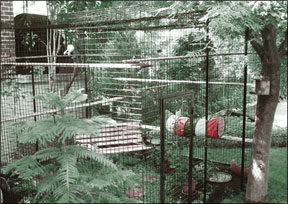Outdoor hazards – such as dogs, coyotes, cars, and disease – face cats that are allowed to roam outdoors. Most veterinarians, including those at the Cornell Universitys College of Veterinary Medicine, strongly recommend that cats be kept indoors. But if your cat does travel beyond your front door, its likely to wander onto the property of your neighbors. While some people will welcome feline visitors, others wont. What can you do to honor Bev Caldwell 288 your cats need to roam – and respect your neighbors rights, too? To choose the best method for dealing with a problem, observe your cats behavior carefully to clarify the issue. For example, one womans cat coexisted peacefully with a backyard bird feeder until it suddenly killed three birds in one week. Upon investigation, she discovered that melting snow had left a depression in the ground. The depression prevented the birds from seeing the cat when it crouched in the hole, making them vulnerable to attack. Once the hole was filled in, the birds were safe again. Incentives. The best defense often is a good offense. Rather than trying to keep your cat away from your neighbors yard, try to, make your own yard so attractive that your cat has no interest in straying. Cats love to dig in soft, tilled earth. Even if you dont have your own garden spot, hoe a patch for your cats. Or save yourself some labor and just dump a load of topsoil over a corner of your yard. You will have to take care of any weeds and soil compaction that occurs, but your cats will be delighted to have their very own outdoor litter box and digging pit. If your cat likes to snack on particular plants in your neighbors yard, plant them in your own. Soft, tasty grasses like wheat, rye, barley and oats are popular with cats; keep them trimmed so they wont go to seed and toughen. Not all cats respond to catnip, but those that do will be delighted to have their own patch. Catnip is a perennial in the mint family, so you may want to plant it in buried or exposed containers so it wont spread throughout your yard. Landscaping so that there are plantings to hide in will also encourage your cat to stay close to home. If your neighbors yard has lots of interesting plantings – and your space has none – your cat will be more likely to stray. If you dont already have a nice climbing spot, consider building or buying a structure. Cats are territorial, and they are likely to prefer to survey the world from a high spot in their own yard rather than from a neighbors trellis. The ideal climbing structure has at least one perch where your cat can comfortably lounge, sun itself, satisfy its instinct for prey-watching, and retreat to when alarmed. The Best of Both Worlds. Finally, consider a cat enclosure. These range from small, portable, tent-like enclosures, to additions built onto a window, to permanent structures that enclose your entire yard. In an enclosure, your cat can enjoy fresh air, sunshine, and outdoor pleasures without any modifications needed in your neighbors yard. Cat enclosures also keep your cat safe from many outdoor hazards, so theyre an excellent choice for you, your cat and your neighbors. (See related article in Catwatch, April 2009.) 



